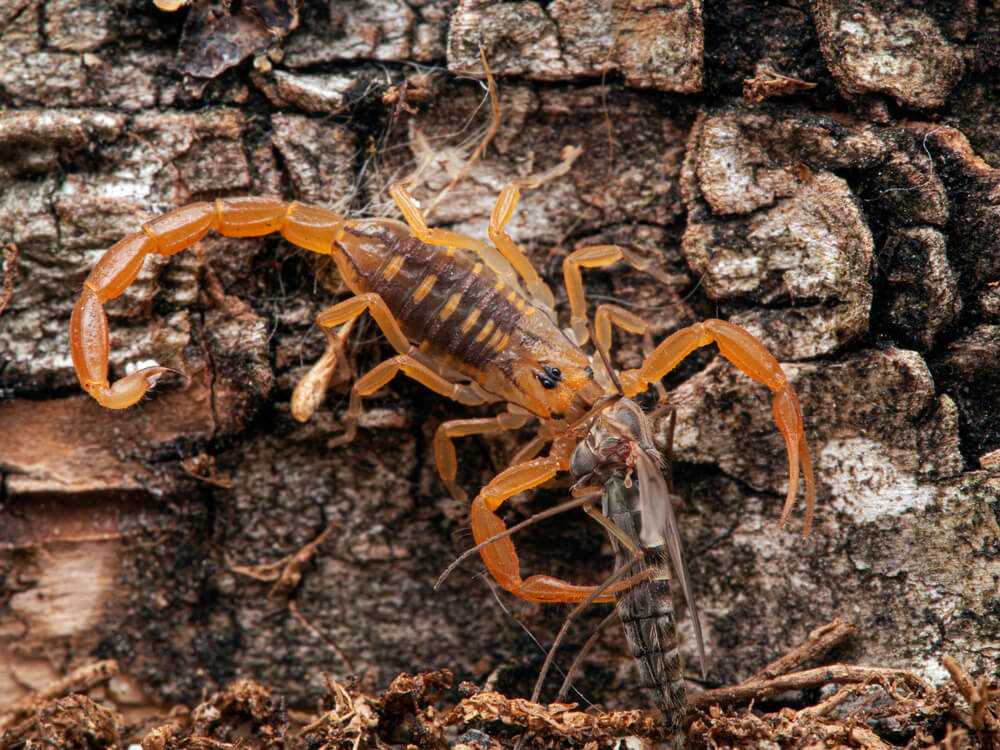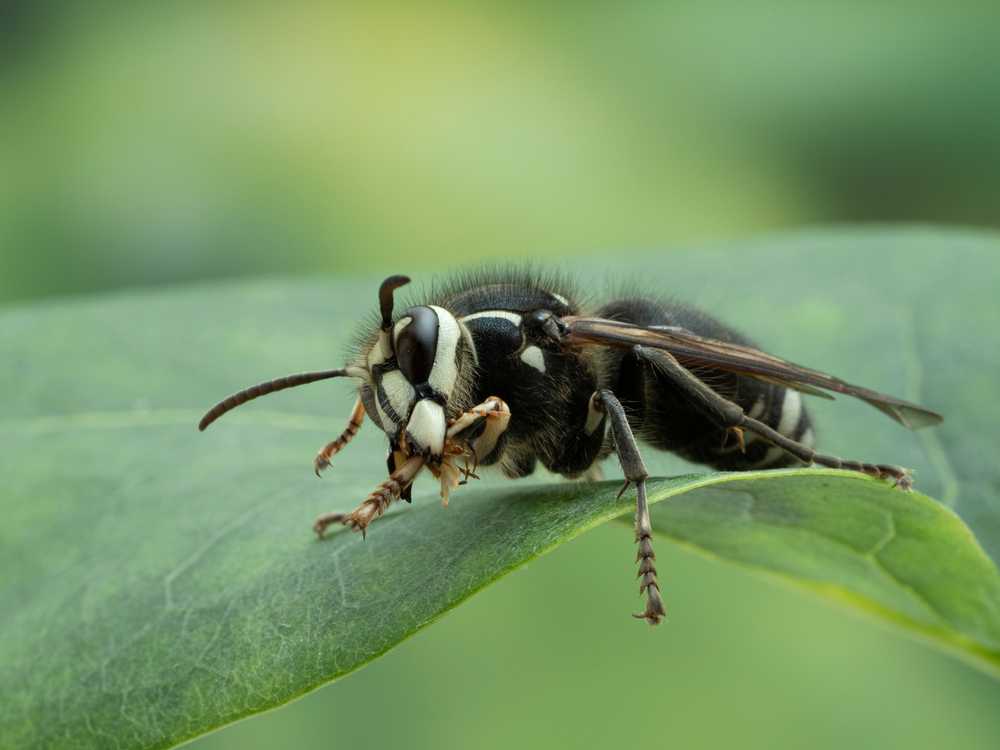Bark Scorpion
Learn about bark scorpions found in Las Vegas and the damage they can cause to your home or business. Contact us for a free inspection today!

Bark Scorpion
Treatments for this pest are included in these services:
How to Identify and Treat a Bark Scorpion Sting
The bark scorpion is a common sight in the Southwestern United States, particularly in Arizona. Known for its venomous sting, it’s essential to recognize and understand this scorpion. In this article, you’ll learn how to identify a bark scorpion, respond to a sting, and take steps to prevent encounters.
Key Takeaways
- The Arizona bark scorpion is the most venomous scorpion species in North America, exhibiting unique climbing abilities and a nocturnal lifestyle, which increases encounters with humans.
- Symptoms of a bark scorpion sting can range from intense pain to severe neurological effects, with immediate first aid and timely medical attention being crucial, especially for vulnerable individuals.
- Preventive measures such as sealing entry points, maintaining a clean yard, and using protective clothing can significantly reduce the risk of scorpion encounters and stings for both humans and pets.
Understanding Bark Scorpions
The Arizona bark scorpion is a common sight in the Southwestern United States, with Arizona being a hotspot for these venomous creatures. Unlike many other scorpion species, bark scorpions have a knack for climbing vertical surfaces, including trees, rocks, and even the walls of your home. This ability allows them to inhabit a variety of environments, making them one of the most frequently encountered scorpion species in the region.
Bark scorpions are nocturnal, emerging from their hiding spots at night to hunt for prey and avoid the scorching daytime heat. Their nocturnal nature, combined with their ability to climb, means they can be found in unexpected places, from tree bark to the corners of your living room.
Knowing their behavior and habitats helps in preventing and managing stings.
Identifying Arizona Bark Scorpions
Recognizing an Arizona bark scorpion is important for appropriate action during an encounter. These scorpions possess unique physical traits and habitat preferences distinguishing them from other species.
Let’s explore these features in detail.
Physical Characteristics
Arizona bark scorpions typically range in size from 2 to 3 inches in length, with males growing slightly larger than females. Their bodies are a light beige or tan color, which helps them blend seamlessly into their desert surroundings. This camouflage makes them difficult to spot, especially in the wild.
In addition to their coloration, Arizona bark scorpions are equipped with large pincers that they use to grasp and capture prey. These pincers, along with their slender bodies and segmented tails, are key identifying features. Their tails end in a sharp stinger, which they use to deliver venom to their victims. Recognizing these characteristics can help you avoid accidental encounters.
Habitat Preferences
Arizona bark scorpions are highly adaptable and can be found in a variety of habitats. They thrive in desert scrubland, urban areas, and suburban neighborhoods. These scorpions are particularly attracted to moist areas, often seeking shelter under rocks, logs, and within dark crevices. They are also drawn to riparian zones, where higher humidity levels make them more active.
Their nocturnal habits and climbing abilities mean they can be found at different heights, including in trees. Keeping your yard tidy and free of debris can help deter these scorpions by eliminating potential hiding spots. Knowing their habitat preferences helps prevent encounters indoors and outdoors.
Venom and Its Effects
The venom of the Arizona bark scorpion is a potent mix of neurotoxins that can have significant effects on the human body. This makes the Arizona bark scorpion the most venomous scorpion species in North America.
Being aware of this venom and its potential effects is key to responding appropriately to a sting.
Why Is the Venom Dangerous?
The venom of a bark scorpion contains neurotoxins, specifically sodium channel toxins, which disrupt normal nervous system function. These toxins cause prolonged activation of sodium channels, leading to excessive neuronal firing and a range of severe symptoms. The venom’s effects can include autonomic dysfunction and cranial nerve issues, making it particularly dangerous for humans.
The symptoms resulting from a bark scorpion sting can be severe, including extreme pain, swelling, and various neuromuscular and ocular effects. The risk posed by these neurotoxins highlights the importance of prompt and appropriate treatment following a sting.
Symptoms of a Sting
A sting from an Arizona bark scorpion is immediately painful, often described as more intense than a bee sting. The initial reaction includes sharp pain and tingling sensations around the sting site. As the venom spreads, severe symptoms such as disorientation, numbness, and even difficulty breathing can occur.
The severity of symptoms can be influenced by several factors, including the age and health of the person stung, their sensitivity to the venom, and the location and depth of the sting. Recognizing these symptoms and their potential severity is essential for effective response to a sting.
What To Do If Stung by a Bark Scorpion
If you or someone you know is stung by a bark scorpion, taking immediate action is crucial. Knowing the steps to take for first aid, when to seek medical attention, and the available treatments can make a significant difference in the outcome.
Let’s break down these steps to ensure you are well-prepared.
Immediate First Aid
Before: The first step after being stung by a scorpion is to clean the affected area with soap and water to prevent infection. Applying a cool compress to the sting site can help reduce pain and swelling. If the sting is on an arm or leg, keeping the limb elevated can also help manage symptoms.
After:
- Clean the affected area with soap and water to prevent infection.
- Apply a cool compress to the sting site to help reduce pain and swelling.
- If the sting is on an arm or leg, keep the limb elevated to help manage symptoms.
Avoid using alcohol or certain medications like aspirin, as they can worsen symptoms. Instead, focus on keeping the wound clean and monitoring for any signs of severe reactions. These immediate actions can help mitigate the effects of the venom and provide relief.
When to Seek Medical Attention
While some scorpion stings may result in mild symptoms, others can escalate quickly and become life-threatening. Children, older adults, and individuals with compromised immune systems are particularly vulnerable and should seek medical attention immediately if stung. Symptoms can peak within five hours, so monitoring closely during this period is essential.
Severe symptoms such as difficulty breathing, rapid heartbeat, and signs of an allergic reaction warrant immediate medical care. Even if symptoms appear mild, consulting with a healthcare professional can provide peace of mind and ensure that the appropriate treatments are administered.
Available Treatments
Treatment for a bark scorpion sting often includes over-the-counter pain relievers like ibuprofen to manage pain. In cases of severe envenomation, antivenom may be necessary to neutralize the venom and prevent serious symptoms. Antivenom functions by binding to the venom present in the blood. This process deactivates the venom, resulting in quick relief.
Doctors may also provide supportive care based on the severity of the symptoms, including intravenous fluids and medications to manage pain and swelling.
Knowing the available treatments ensures you and your loved ones receive the necessary care after a sting.
Preventing Bark Scorpion Encounters
Preventing encounters with bark scorpions involves taking proactive measures around your home and yard. Simple precautions can significantly reduce the risk of these venomous creatures making their way into your living spaces.
Let’s explore the steps you can take to keep bark scorpions at bay.
Home and Yard Precautions
To keep bark scorpions out of your home, follow these steps:
- Regularly check and seal any cracks in doors and windows.
- Sealing potential entry points can prevent not only scorpions but also their prey, such as insects, from entering your home.
- Keep areas well-lit to deter scorpions, as they prefer dark environments.
By implementing these measures, you can help protect your home from bark scorpions.
In your yard, eliminating clutter and debris is crucial, as these can provide hiding spots for scorpions. Regularly cleaning and vacuuming the home, trimming palm trees, and clearing overhanging branches can reduce the likelihood of scorpions gaining access to your living spaces.
Personal Safety Measures
Personal safety measures are also important in preventing scorpion stings. Always wear shoes when outdoors to avoid direct contact with scorpions. Wearing closed-toe shoes provides an added layer of protection and reduces the risk of stings.
Before using any clothing or gear, make a habit of shaking them out to ensure no scorpions are hiding inside. This simple precaution can prevent unexpected stings and keep you safe while enjoying outdoor activities.
Bark Scorpions and Pets
Pets, particularly dogs and cats, are also at risk of bark scorpion stings. Knowing how to protect your furry friends and recognizing the symptoms of a sting can help you act quickly to ensure their safety.
Let’s delve into the risks and safety tips for pets.
Risks to Dogs and Cats
Bark scorpion stings can cause severe symptoms in pets due to their smaller size, making prompt veterinary care essential. Symptoms in dogs can include yelping, holding up a paw, watery eyes, excessive drooling, and even respiratory issues. Cats, while generally more agile, are not immune to stings and can also suffer from severe reactions.
If you notice any signs of a scorpion sting in your pet, such as excessive drooling, difficulty standing, or respiratory distress, seek veterinary care immediately. The Arizona bark scorpion is the only scorpion species in the U.S. that poses a deadly threat to both pets and humans, underscoring the importance of timely intervention.
Pet Safety Tips
To protect your pets from bark scorpions, regularly inspect your yard for scorpions and keep pet areas clean. Sealing entry points to your home can also help reduce your pet’s exposure to these venomous creatures. Keeping the yard clear of debris and preventing pets from digging can significantly minimize the risk of encounters.
Supervising your pets when they are outside and ensuring they do not play or sleep in areas that may be infested with scorpions can further protect them from stings. These safety tips can help keep your furry friends safe and scorpion-free.
Interesting Facts About Bark Scorpions
Beyond their venomous nature, bark scorpions have some fascinating characteristics that make them unique. From their life cycle to their remarkable adaptations, these scorpions are more than just a backyard menace.
Let’s explore some interesting facts about bark scorpions.
Life Cycle and Behavior
Bark scorpions have a lifespan that can range from 2 to 6 years in the wild, depending on environmental conditions. They are nocturnal creatures, meaning they are most active at night, which is when they hunt and mate. Their diet primarily consists of various insects, spiders, and even other scorpions, making them both predators and prey in their ecosystems.
The life cycle of a bark scorpion involves several molts, where they shed their exoskeleton to grow. They give birth to live young, which ride on the mother’s back until their first molt, providing them with protection during their most vulnerable stage.
Knowing their behavior and life cycle aids in creating effective strategies for managing their presence around your home.
Unique Adaptations
One of the most striking adaptations of the bark scorpion is its ability to fluoresce under ultraviolet light. This glowing effect makes them easier to spot at night with a UV flashlight, helping to avoid accidental encounters. This trait is not just a curiosity; it’s a practical tool for homeowners to detect and manage scorpions.
Bark scorpions also exhibit a unique resistance to the venom of certain predators, such as grasshopper mice, which allows them to survive attacks that would deter other scorpions. Additionally, they have a preference for hanging upside down, a behavior known as negative geotaxis, which can lead to accidental stings if they are disturbed in this position.
These adaptations highlight the remarkable resilience and survival strategies of bark scorpions.
Frequently Asked Questions
What immediate steps should I take if stung by a bark scorpion?
If stung by a bark scorpion, promptly clean the wound with soap and water, apply a cool compress, and keep an eye on any severe symptoms. Taking these immediate steps is crucial for your safety.
How can I identify an Arizona bark scorpion?
You can identify an Arizona bark scorpion by its light beige or tan color, large pincers, and size of 2 to 3 inches. These characteristics are key indicators of this species.
When should I seek medical attention after a sting?
If you have difficulty breathing or experience significant swelling after a sting, it is crucial to seek immediate medical attention. Timely care can prevent serious complications.
Are bark scorpions dangerous to pets?
Bark scorpions are indeed dangerous to pets, as their venom can lead to serious health issues, requiring immediate veterinary attention.
What are some ways to prevent scorpion encounters in my home?
To prevent scorpion encounters in your home, seal cracks in doors and windows, maintain a tidy yard, and install yellow outdoor lights to reduce insect attraction. Following these steps will significantly minimize the risk of scorpions entering your living space.
Request Your Free Scorpion Control Quote Today
Scorpions feed on insects and even on other scorpions, which is why they can be a difficult pest to control. The fewer bugs you have in your home, the less reason for scorpions to hang around. When you lean on the pest professionals at Las Vegas Pest Control, you can enjoy peace of mind knowing your home or business will be pest-free and protected from future infestation. Give our team a call or fill out our contact form for your free quote or to schedule an inspection!


